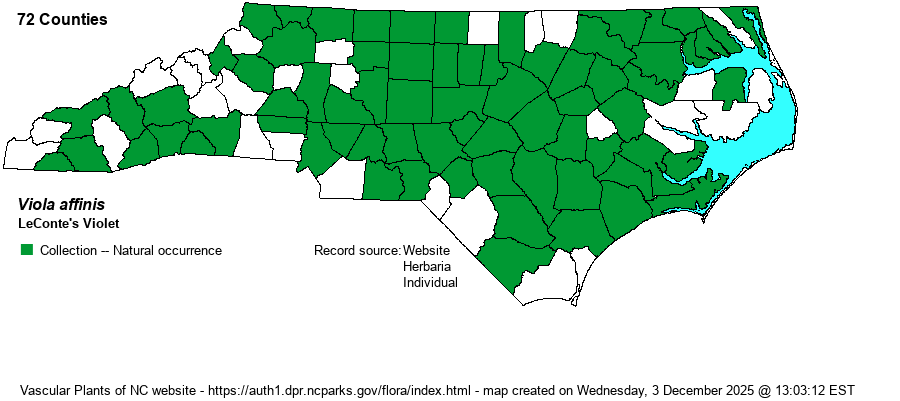| Author | Le Conte | |
| Distribution | This species occurs nearly throughout the state, but is primarily found in the Coastal Plain and the eastern and central Piedmont.
This is an Eastern species, ranging from eastern Canada south to central FL and LA. | |
| Abundance | Fairly common to common in the eastern and central Piedmont and most of the Coastal Plain, though very rare toward the northeastern coast. Uncommon and perhaps local in the Mountains and western Piedmont. | |
| Habitat | This is essentially a wetland forest violet, growing in bottomland hardwoods and in drier portions of swamp forests. It does not grow on slopes or into upland forests. |
| Phenology | Blooms from March to May, and fruits soon after flowering. | |
| Identification | This is a rather standard-looking violet, easily confused with the very common V. sororia, which often grows with it in the same bottomland forests. V. affinis has its triangular to narrowly ovate leaves noticeably longer than wide, about 2-2.5 inches long and 1.5 inches wide, with a distinctly acuminate or long tapered tip. V. sororia has more cordate looking leaves only slightly longer than wide, if even that. Also, V. affinis has the leaf blade essentially glabrous, except for obvious hairs on the upper side of the basal lobes, and the flower stalk is generally glabrous. Lastly, the petal with the spur is bearded on the inside of the throat. Take care when identifying this and several other species, as V. sororia is so common and rather variable (and likely still consists of several entities); the triangular leaf with the long and tapered tip, as opposed to a rather heart-shaped leaf, is the best clue to its identity. | |
| Taxonomic Comments | None
General note on Viola: In 2009-10 B.A. Sorrie (website map editor) went through the whole collection at NCU, annotating all specimens against those verified by experts in the genus. The range maps in RAB (1968) have been changed accordingly. More recently, Harvey Ballard and colleagues are in the process of revising all Eastern and Southeastern Viola, and have annotated all specimens at NCU in July 2024. They recognize additional species not in RAB or in previous editions of Weakley et al.; we will follow updated editions of Weakley et al. in recognizing them. Species range maps have been adjusted to account for identification changes. | |
| Other Common Name(s) | Sand Violet. Most references use Sand Violet, but this is a poor name, as the species grows in wet to damp ground in rich floodplain soil, and not in sandy soil in NC. Note that some references also use Sand Violet as a common name for V. fimbriatula, and thus to avoid confusion, V. affinis is here named as LeConte's Violet, used by several references, and long in use by wildflower enthusiasts from Peterson and McKenny (1968). | |
| State Rank | S4 [S5] | |
| Global Rank | G5 | |
| State Status | | |
| US Status | | |
| USACE-agcp | FACW link |
| USACE-emp | FACW link |

